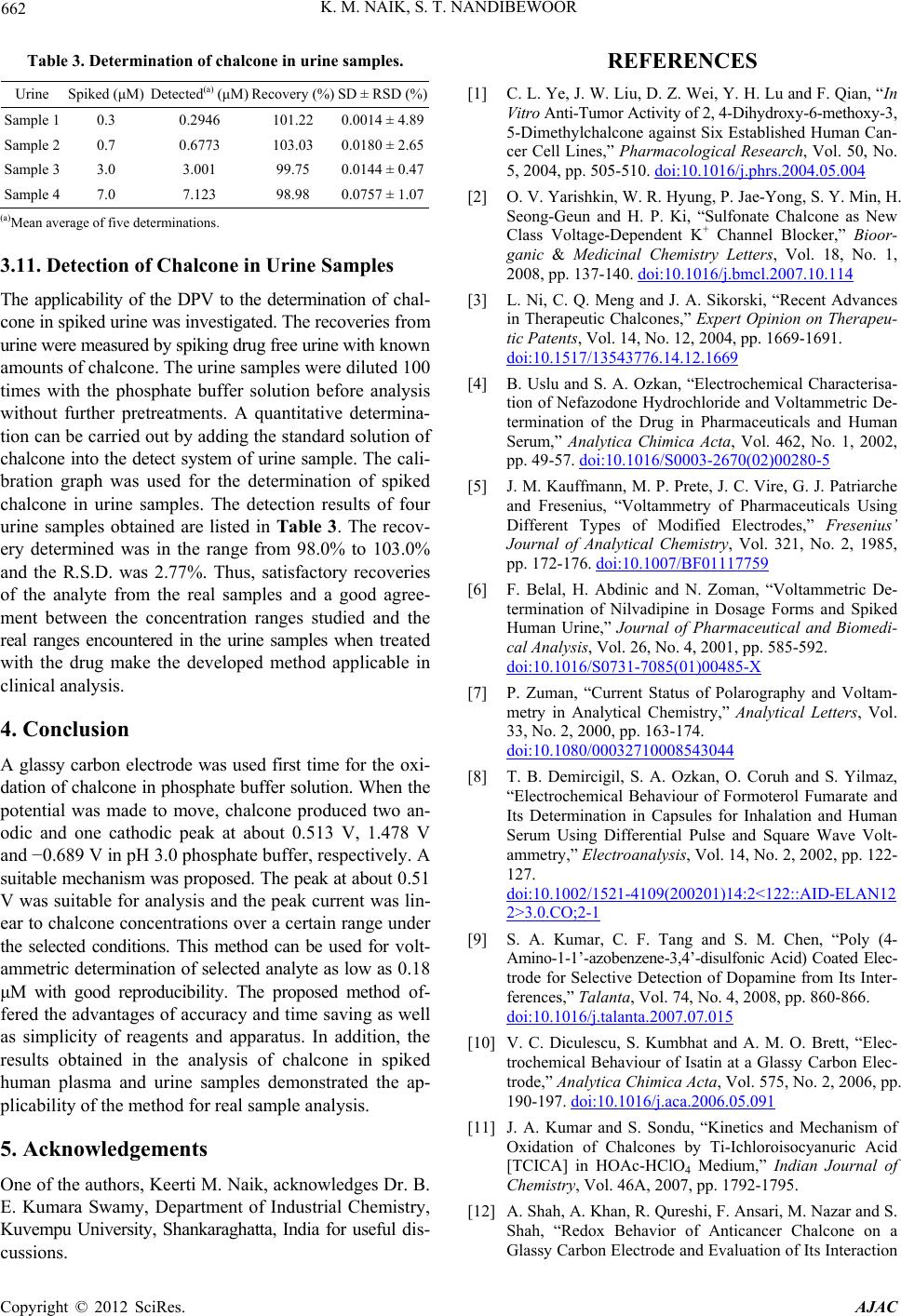
K. M. NAIK, S. T. NANDIBEWOOR
662
Table 3. Determination of chalcone in urine samples.
Urine Spiked (μM) Detected(a) (μM) Recovery (%) SD ± RSD (%)
Sample 1 0.3 0.2946 101.22 0.0014 ± 4.89
Sample 2 0.7 0.6773 103.03 0.0180 ± 2.65
Sample 3 3.0 3.001 99.75 0.0144 ± 0.47
Sample 4 7.0 7.123 98.98 0.0757 ± 1.07
(a)Mean average of five determinations.
3.11. Detection of Chalcone in Urine Samples
The applicability of the DPV to the determination of chal-
cone in spiked urine was investigated. The recoveries from
urine were measured by spiking drug free urine with known
amounts of chalcone. The urine samples were diluted 100
times with the phosphate buffer solution before analysis
without further pretreatments. A quantitative determina-
tion can be carried out by adding the standard solution of
chalcone into the detect system of urine sample. The cali-
bration graph was used for the determination of spiked
chalcone in urine samples. The detection results of four
urine samples obtained are listed in Table 3. The recov-
ery determined was in the range from 98.0% to 103.0%
and the R.S.D. was 2.77%. Thus, satisfactory recoveries
of the analyte from the real samples and a good agree-
ment between the concentration ranges studied and the
real ranges encountered in the urine samples when treated
with the drug make the developed method applicable in
clinical analysis.
4. Conclusion
A glassy carbon electrode was used first time for the oxi-
dation of chalcone in phosphate buffer solution. When the
potential was made to move, chalcone produced two an-
odic and one cathodic peak at about 0.513 V, 1.478 V
and −0.689 V in pH 3.0 phosphate buffer, respectively. A
suitable mechanism was proposed. The peak at about 0.51
V was suitable for analysis and the peak current was lin-
ear to chalcone concentrations over a certain range under
the selected conditions. This method can be used for volt-
ammetric determination of selected analyte as low as 0.18
μM with good reproducibility. The proposed method of-
fered the advantages of accuracy and time saving as well
as simplicity of reagents and apparatus. In addition, the
results obtained in the analysis of chalcone in spiked
human plasma and urine samples demonstrated the ap-
plicability of the method for real sample analysis.
5. Acknowledgements
One of the authors, Keerti M. Naik, acknowledges Dr. B.
E. Kumara Swamy, Department of Industrial Chemistry,
Kuvempu University, Shankaraghatta, India for useful dis-
cussions.
REFERENCES
[1] C. L. Ye, J. W. Liu, D. Z. Wei, Y. H. Lu and F. Qian, “In
Vitro Anti-Tumor Activity of 2, 4-Dihydroxy-6-methoxy-3,
5-Dimethylchalcone against Six Established Human Can-
cer Cell Lines,” Pharmacological Research, Vol. 50, No.
5, 2004, pp. 505-510. doi:10.1016/j.phrs.2004.05.004
[2] O. V. Yarishkin, W. R. Hyung, P. Jae-Yong, S. Y. Min, H.
Seong-Geun and H. P. Ki, “Sulfonate Chalcone as New
Class Voltage-Dependent K+ Channel Blocker,” Bioor-
ganic & Medicinal Chemistry Letters, Vol. 18, No. 1,
2008, pp. 137-140. doi:10.1016/j.bmcl.2007.10.114
[3] L. Ni, C. Q. Meng and J. A. Sikorski, “Recent Advances
in Therapeutic Chalcones,” Expert Opinion on Therapeu-
tic Patents, Vol. 14, No. 12, 2004, pp. 1669-1691.
doi:10.1517/13543776.14.12.1669
[4] B. Uslu and S. A. Ozkan, “Electrochemical Characterisa-
tion of Nefazodone Hydrochloride and Voltammetric De-
termination of the Drug in Pharmaceuticals and Human
Serum,” Analytica Chimica Acta, Vol. 462, No. 1, 2002,
pp. 49-57. doi:10.1016/S0003-2670(02)00280-5
[5] J. M. Kauffmann, M. P. Prete, J. C. Vire, G. J. Patriarche
and Fresenius, “Voltammetry of Pharmaceuticals Using
Different Types of Modified Electrodes,” Fresenius’
Journal of Analytical Chemistry, Vol. 321, No. 2, 1985,
pp. 172-176. doi:10.1007/BF01117759
[6] F. Belal, H. Abdinic and N. Zoman, “Voltammetric De-
termination of Nilvadipine in Dosage Forms and Spiked
Human Urine,” Journal of Pharmaceutical and Biomedi-
cal Analysis, Vol. 26, No. 4, 2001, pp. 585-592.
doi:10.1016/S0731-7085(01)00485-X
[7] P. Zuman, “Current Status of Polarography and Voltam-
metry in Analytical Chemistry,” Analytical Letters, Vol.
33, No. 2, 2000, pp. 163-174.
doi:10.1080/00032710008543044
[8] T. B. Demircigil, S. A. Ozkan, O. Coruh and S. Yilmaz,
“Electrochemical Behaviour of Formoterol Fumarate and
Its Determination in Capsules for Inhalation and Human
Serum Using Differential Pulse and Square Wave Volt-
ammetry,” Electroanalysis, Vol. 14, No. 2, 2002, pp. 122-
127.
doi:10.1002/1521-4109(200201)14:2<122::AID-ELAN12
2>3.0.CO;2-1
[9] S. A. Kumar, C. F. Tang and S. M. Chen, “Poly (4-
Amino-1-1’-azobenzene-3,4’-disulfonic Acid) Coated Elec-
trode for Selective Detection of Dopamine from Its Inter-
ferences,” Talanta, Vol. 74, No. 4, 2008, pp. 860-866.
doi:10.1016/j.talanta.2007.07.015
[10] V. C. Diculescu, S. Kumbhat and A. M. O. Brett, “Elec-
trochemical Behaviour of Isatin at a Glassy Carbon Elec-
trode,” Analytica Chimica Acta, Vol. 575, No. 2, 2006, pp.
190-197. doi:10.1016/j.aca.2006.05.091
[11] J. A. Kumar and S. Sondu, “Kinetics and Mechanism of
Oxidation of Chalcones by Ti-Ichloroisocyanuric Acid
[TCICA] in HOAc-HClO4 Medium,” Indian Journal of
Chemistry, Vol. 46A, 2007, pp. 1792-1795.
[12] A. Shah, A. Khan, R. Qureshi, F. Ansari, M. Nazar and S.
Shah, “Redox Behavior of Anticancer Chalcone on a
Glassy Carbon Electrode and Evaluation of Its Interaction
Copyright © 2012 SciRes. AJAC